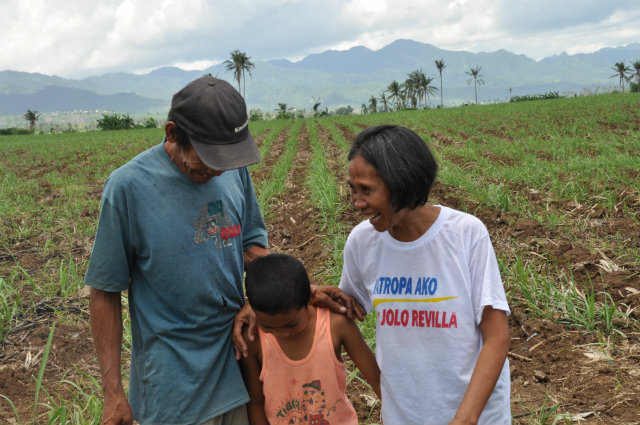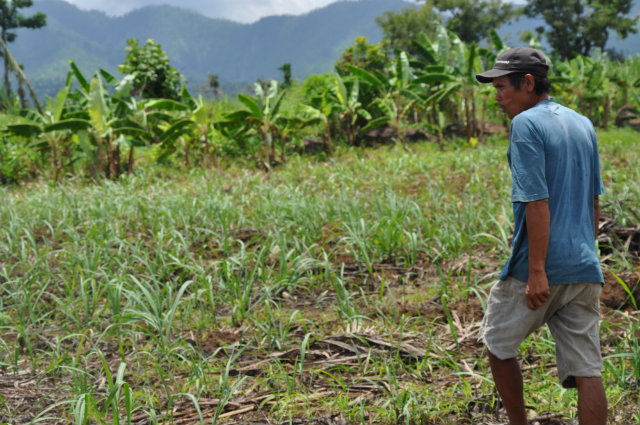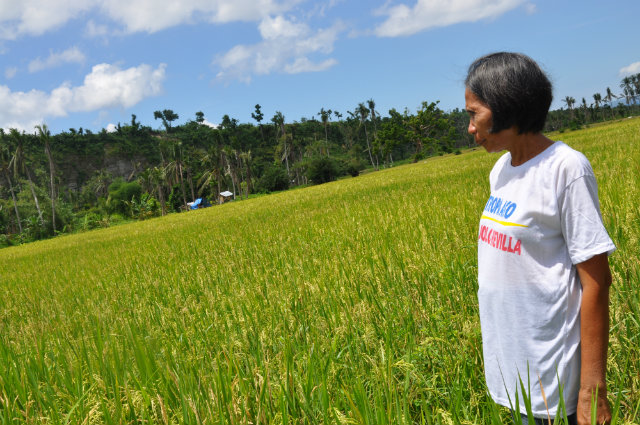SUMMARY
This is AI generated summarization, which may have errors. For context, always refer to the full article.
LEYTE, Philippines – Six months after Super Typhoon Yolanda (Haiyan), the people in the village of Sumangga, Ormoc City are still struggling to get back on their feet.
To them, eating 3 times a day is a luxury. (READ: When hunger is a daily battle)
The couple Linda and Nestor was born, and will also most likely, die as sugarcane workers. (READ: PH farmers, invisible food producers)
When Yolana struck and destroyed all crops, things went really bad for the couple. (READ: Yolanda’s damage on agriculture)
“We didn’t have work for 3 months. Before, even if the pay is low, there is something we can look forward to every Saturday. But after Haiyan, we were left with nothing. Not even our house,” said 55-year old Nestor. (READ: Hungry, homeless, jobless after Yolanda)
Known as an agricultural city, Ormoc suffered losses in agriculture amounting to P3.25 billion, based on the initial assessment of the City Agriculture Office. The sugarcane industry incurred P1.09 billion losses, while the rice industry lost over P149 million.
For couples like Nestor and Linda, who depended on their small farm for their rice supply, the losses were a threat to their survival. (READ: How much do farmers lose?)
“We used to harvest at least 6 sacks of rice per cropping season but because of the typhoon, we only got two sacks. We had to give one sack to the farm owner, or else our debt will pile up.” (READ: How climate change threatens food security)
Ten-year old John Luke, grandson of Nestor and Linda, dreams of becoming a painter someday. “I want to study in Manila and become a painter. I want to help my grandparents,” he said. “I want to buy them a farm of their own.”
Loss, livelihood, life
In February, the sugarcane workers resumed work, paid at a rate of P70/day. Each worker endured working either under extreme weather conditions.
“It was fine for us before because we had medical benefits. But after the typhoon, our employers cut them off because of their business losses. We cannot afford to go for hospitalization even when sick. Our money is not even enough for food,” Nestor said.
Showing the vast sugarcane farm around his village, Nestor added, “Do you see that? The farm is vast but most farm owners now use chemicals for removing weeds. This used to be work for us, but now, even new technology poses as a competition. We badly need help.” (READ: Why PH agriculture is important)
After Haiyan, the City Agriculture Office assisted farmers by giving rice seeds and fertilizers.
Judy Mendiola, agricultural technologist, however explained that production is poor because the farms lacked water during the reproductive and vegetative phase. One of the major concerns in the area is source of water supply.
“Pests, diseases and the unpredictable weather compounded the problem,” she added.
Interventions
World Vision is working with farmers on their livelihood needs.
With the growing concern for food security, farmer trainers were tapped to provide people with technical assistance on vegetable production. Vegetable seeds were also distributed for community gardens. (READ: Fighting malnutrition with veggies)
There is also an on-going Cash-for-Work program across its served areas; it provides people with a temporary source of income. To date, there are 7,209 beneficiaries reached out of a total target of 8,500.
Cash-for-Work involves 10-day community work and each beneficiary receives P2,600 after the program.
Further, World Vision has partnered with the Technical Education and Skills Development Authority (TESDA) to provide carpentry training for the interested beneficiaries. Aside from increasing their capacity, the training likewise aims to capacitate people to pass the competency assessment for the National Certification (NCII) which will give them better chances for jobs.
Graduates of the training are provided with employment opportunity by engaging them in the construction of the targeted number of new houses for the most vulnerable beneficiaries.
Future plans include livestock distribution and intercropping systems.
“We will also provide support in intercropping practices in upland areas. For coconut farmers, it will take 7 years before the trees grow hence we will be providing garden tools, farming inputs and trainings,” Emelia Lasquites, livelihood coordinator for Western Leyte, explained.
The program will be done in partnership with the Department of Agriculture, the Philippine Coconut Authority and local government units (LGUs).
“I pray that poverty will end in my generation. I don’t want my grandson to be worrying about what to eat every single day and I want to see him fulfill his dreams. We can only help him make that happen if we have source of income,” Linda said. – Rappler.com
For more information about World Vision Haiyan Response, please contact Communications Manager Cecil Laguardia: cecil_laguardia@wvi.org, 0939-9262669.
Joy Maluyo is a Communication Officer for World Vision’s Haiyan Response. She is currently deployed in the Visayas and is moving around World Vision’s assisted areas in Panay Island, North Cebu, and Leyte.
Add a comment
How does this make you feel?



There are no comments yet. Add your comment to start the conversation.